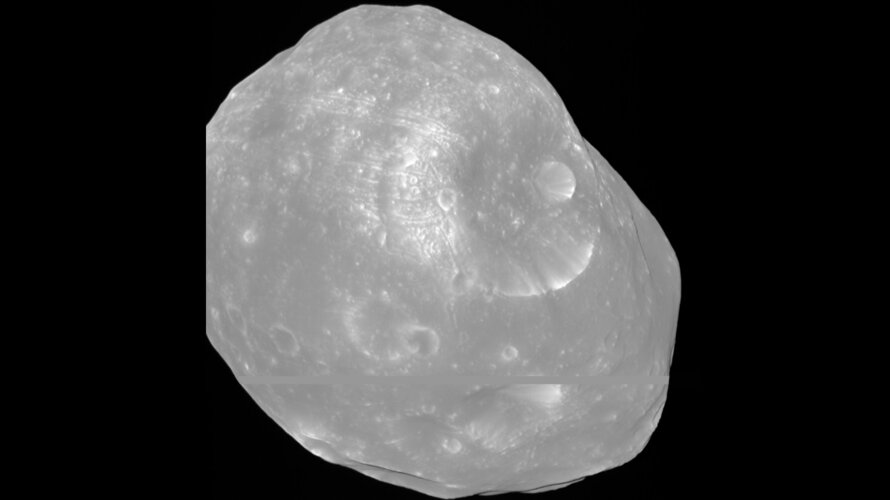
Video:
00:00:28
ESA’s Mars Express recently tracked Phobos as the moon passed in front of the spacecraft’s camera, capturing detailed views of the small, irregularly shaped body at different angles and stages of the flyby. This sequence comprises 41 images taken by the High Resolution Stereo Camera’s Super Resolution Channel on 17 November 2019 during orbit 20 076, when Phobos passed Mars Express at a distance of roughly 2400 km. The images have a resolution of 21 m/pixel.
This opportunity allowed the spacecraft to capture many features across the moon’s surface; alongside a number of impact craters (including the large and prominent Stickney crater), one can see a number of linear marks and furrows.
The movie shows Phobos at a number of angles – the moon can be seen rotating, and slowly lightens up before it begins to darken again. The slight up-and-down motion of the moon is caused by the oscillation of Mars Express. It nicely illustrates the concept of ‘phase angle’: the angle between a light source (in this case, the Sun) and the observer (Mars Express’ HRSC), as viewed from the target object itself (Phobos). The initial phase angle is 17 degrees, drops to almost 0 degrees mid-way through (0.92, when Phobos is at its brightest), and then rises to 15 degrees by the end of the animation.
This arrangement – of the Sun, Mars Express and Phobos where the latter is observed at a phase angle of near zero degrees – is very rare, and happens only three times a year at most. Other chances to achieve a phase angle of under one will not occur until April and then September of 2020. As such, Mars Express takes every opportunity to view this small and intriguing moon from this angle, to shed light on its properties, behaviour, possible origin, orbital characteristics and location in space – and to probe its potential as a mission destination.
|
Mars Express views Phobos phases
ESA’s Mars Express recently tracked Phobos as the moon passed in front of the spacecraft’s camera, capturing detailed views of the small, irregularly shaped body at different angles and stages of the flyby. This sequence comprises 41 images taken by the High Resolution Stereo Camera’s Super Resolution Channel on 17 November 2019 during orbit 20 076, when Phobos passed Mars Express at a distance of roughly 2400 km. The images have a resolution of 21 m/pixel.
This opportunity allowed the spacecraft to capture many features across the moon’s surface; alongside a number of impact craters (including the large and prominent Stickney crater), one can see a number of linear marks and furrows.
The movie shows Phobos at a number of angles – the moon can be seen rotating, and slowly lightens up before it begins to darken again. The slight up-and-down motion of the moon is caused by the oscillation of Mars Express. It nicely illustrates the concept of ‘phase angle’: the angle between a light source (in this case, the Sun) and the observer (Mars Express’ HRSC), as viewed from the target object itself (Phobos). The initial phase angle is 17 degrees, drops to almost 0 degrees mid-way through (0.92, when Phobos is at its brightest), and then rises to 15 degrees by the end of the animation.
This arrangement – of the Sun, Mars Express and Phobos where the latter is observed at a phase angle of near zero degrees – is very rare, and happens only three times a year at most. Other chances to achieve a phase angle of under one will not occur until April and then September of 2020. As such, Mars Express takes every opportunity to view this small and intriguing moon from this angle, to shed light on its properties, behaviour, possible origin, orbital characteristics and location in space – and to probe its potential as a mission destination. |
Click here for original story, Mars Express views Phobos phases
Source: ESA Space News